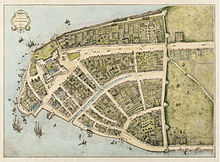Environmental issues in New York City
[7] New York has the largest clean air diesel-hybrid and compressed natural gas bus fleet in the country, and some of the first hybrid taxis.
[10] New York has the largest clean-air diesel-hybrid and compressed natural gas bus fleet in the country, and some of the first hybrid taxis.
[9] Environmental groups make large efforts to help shape legislation in New York because they see the strategy as an efficient way to influence national programs.
The city was a petitioner in the landmark Massachusetts v. Environmental Protection Agency Supreme Court case forcing the EPA to regulate greenhouse gases as pollutants.
Throughout the history of New York City, there has been undenied mistreatment of vulnerable populations in various aspects which has led to present day environmental injustices that plague many of the neighborhoods that these people live in.
This resulted in many areas (those with high minority populations) not receiving proper development, investment, and poor infrastructure decisions.
The city's uniquely high density, encouraged by much of it being surrounded by water, facilitates the highest rate of mass transit use in the United States.
[18] The city's mass transit system, multifamily housing, mixed neighborhoods and the fact that greenfield land is no longer available to development, make building in New York very energy efficient.
Detailed measures included switching more than 11,000 traffic lights and pedestrian signals in the city to new energy-efficient light-emitting diodes that use 90% less energy than conventional fixtures.
[23] According to the 2000 U.S. Census, New York City is the only locality in the United States where more than half of all households do not own a car (the figure is even higher in Manhattan, over 75%; nationally, the rate is 8%).
[27] The city's extraordinary public transit use means that New Yorkers emit far fewer greenhouse gases on a per capita basis than the average American.
In the post-World War II construction boom, changes in zoning regulations and the widespread use of air conditioning led to the design of sealed glass and steel towers.
The city's Department of Design and Construction developed a set of guidelines in 1999 that encourage environmentally sound building methods for municipal projects.
[29] According to the most recent U.S. Environmental Protection Agency (EPA) National-Scale Air Toxics Assessment study, residents of New York County, NY (Manhattan), have the third highest cancer risk caused by airborne chemicals of all counties in the United States (including the District of Columbia, Puerto Rico, and the Virgin Islands).
The study was designed to estimate the change in violent and nonviolent criminal behavior risk associated with short-term air pollution in U.S. counties.
The study evaluated the exposure-response relation and assessed differences in risk by community characteristics of poverty, urbanicity, race, and age.
He concluded that the pollutant carbon monoxide, when present in high concentration increased violent crimes in the city in a U-shaped relation.
However with air pollutant increasing during February, June through August, November and December,[36] it was not on the FBI 2022’s ten most dangerous cities in New York State.
[18] A combination of stakeholder interests regarding profit and a lack of space in NYC leads to air pollution being a difficult issue to solve.
This can be defined as “the planned and deliberate targeting of Black and Brown communities in deciding where to place roadways, toxic waste facilities, along with industrial and commercial sites like bus depots and tractor trailer distribution centers” (Dow, 2020).
Health professionals and researchers believe that these glaring disparities created a "perfect storm of events" that led to the Bronx becoming an early COVID-19 epicenter.
Phosphoric acid is added to create a protective film on pipes that reduces the release of metals such as lead and copper from household plumbing.
Engineering studies in 1903 recognized that the clay of the steeply sloped eastern Catskills turned the clear waters of the Schoharie and Esopus Creeks muddy after storms.
[44] Turbidity problems continued in the Croton system throughout the 20th century, leading to violations of environmental regulations and a 1997 lawsuit against the city by the federal government and the State of New York.
[42] The city added ultraviolet disinfection (UV) treatment in the early 21st century, to eliminate protozoa such as cryptosporidium and giardia.
In 2006 Mayor Michael Bloomberg signed legislation establishing a new solid waste management plan, which will use barges and trains to export 90% of the city's 12,000 daily tons of residential trash.
Passage of the new legislation was delayed by opponents in a Manhattan neighbourhood who protested the use of a marine transfer station in the Hudson River Park.
Environmentalists and social activists argued the plan promoted environmental justice because no one borough or neighbourhood would bear a disproportionate burden under the proposal, and they, therefore, supported it.
Populations of wild South American monk parakeets, also known as the Quaker parrot, live in Greenwood Cemetery, Marine Park, Bensonhurst, and Bay Ridge in Brooklyn, and in the East Bronx.
The slow pace of the cleanup, however, has increasingly angered Greenpoint residents and elected officials, who have launched a series of lawsuits against ExxonMobil in 2004.




